Dubai:It’s a curious feeling to stand inside a building while it’s being swallowed by the land on which it stands. At least that’s the best way I can describe the experience of visiting the abandoned desert village of Al Ghuraifa,less than 100 kilometres from the bustling Gulf city of Dubai.
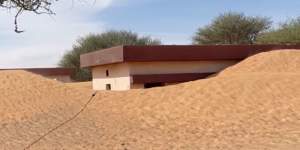
Al Ghuraifa,a village less than an hour’s drive from Dubai is being consumed by the dunes.Lucy Cormack
Twelve boxy cement houses – windows and doors long gone – and a small mosque with sun-bleached paint trimming its minaret are all that remain of the settlement built in the 1970s for a semi-nomadic Bedouin tribe. Some of the buildings are now set so deep in the dunes,the sand inside them nearly touches the ceiling.
Researchers believe the Al Ghuraifa community existed for little more than 15 years before people left to escape the punishing sandstorm conditions common to the area. Although locals have long suggested the site was overcome by dark spirits,earning it its “ghost village” moniker.
Today the uninhabited site is a popular stop for Insta-loving travellers and cultural groups in search of backdrops for videos and art exhibitions.
Al Ghuraifa is an abandoned settlement less than 100 kilometres from the Gulf city of Dubai.
All around stretches an endless desert horizon of undulating dunes,with a passing caravan of camels to complete the picture. From this vantage point,it’s easy to forget the Dubai metropolis is less than an hour away,the buzzing nucleus of a nation just 52 years old.
As quickly as Al Ghuraifa is being reclaimed by the sand;highways,housing estates and high-rises are sprouting in Dubai,where the population surged above 3.6 million for the first time this year.
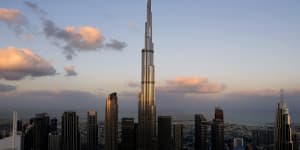
Desert miracle:Dubai skyline with the moon on the tip of Burj Khalifa,the world’s tallest building.AP
Although the United Arab Emirates is the world’s seventh largest oil-producing nation,oil exports today account for less than 30 per cent of its GDP,a figure the futuristic petrostate is anxious to promote as it races with frenetic pace to diversify its economy and attract foreign investment.
The figure was rattled off more than once at the COP28 UN climate summit which Dubai hosted over the past two weeks – much to the criticism of climate advocates and green groups sceptical of the UAE’s objectives after it appointed the head of the country’s state-owned oil company Sultan Ahmed al-Jaber to shepherd the talks.
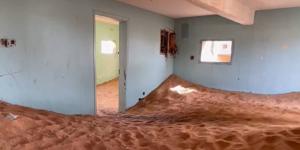
The inside view of an abandoned home in Al Ghuraifa.Lucy Cormack
This was my first experience of a COP event,which at times seemed like a giant airport arrivals hall,jutting up against an energy industry trade fair,colliding with an environmental jamboree – with a smattering of world leaders and delegations thrown in. And of course,there was no avoiding the cloud of the war in Gaza hanging over the event and threatening to distract progress.
By all accounts,this 2023 edition was the largest COP event ever,with more than 100,000 people on site at its peak. You had to wonder about the carbon emissions involved in just getting everyone to the Gulf city for the affair,many on private jets.
In a country where organised political groups are effectively outlawed,I was particularly eager to see how the event’s designated protest zone would function. AsThe New York Times put it this week,COP28 brought “the rare spectacle of political mobilisation to the UAE,the authoritarian host”.
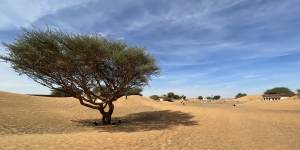
The abandoned desert village of Al Ghuraifa outside Dubai.Lucy Cormack
Most days at Dubai’s Expo City,I happened upon one activist group or another:the protesters in Hazmat suits decrying the climate “crime scene” in Africa;the 12-year-old advocate who had travelled from India to bellow passionately into a megaphone about the colliding crises of flood,drought and air pollution consuming her home.
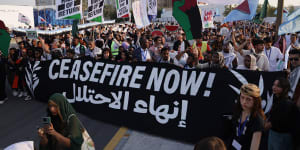
Activists march in protest on day nine of COP28.Getty
The task of getting 200 countries to all agree on how to solve the climate crisis seemed gargantuan at the start of COP28. This week,the scale of the challenge came into even sharper focus when,in the summit’s final hours,a new draft text was proposed that lacked any calls for the rapid phase-out or phase-down of fossil fuels,bitterly dividing negotiators.
It wasn’t until a day after the talks were due to have ended and following two marathon nights of tough negotiations that was finally reached supporting a “transition away from fossil fuels” – a result the UAE presidency claimed as a win. But while it may be the first time in COP history that the agreed text among nations directly mentions the prime underlying cause of climate change,it also includes support for the use of controversial abatement technologies like carbon capture and storage:a cop out,climate activists say,that will extend the life of fossil fuels.
Australia’s Climate Change Minister Chris Bowen conceded the agreement did not go as far as some wanted but said it still sent a clear signal of a world in agreement that “our future is in clean energy and the age of fossil fuels will end”.
It’s a long way from the impasse between voting blocs at the start of the week when Australia,along with the US,UK,Norway and Canada,refused to support wording put forward by oil rich nations that failed to address fossil fuels. But while the final agreement may be a diplomatic win for the UAE,many nations will head home from Dubai disappointed that the language is too weak for the scale of the crisis upon us.
Get a note directly from our foreigncorrespondentson what’s making headlines around the world..